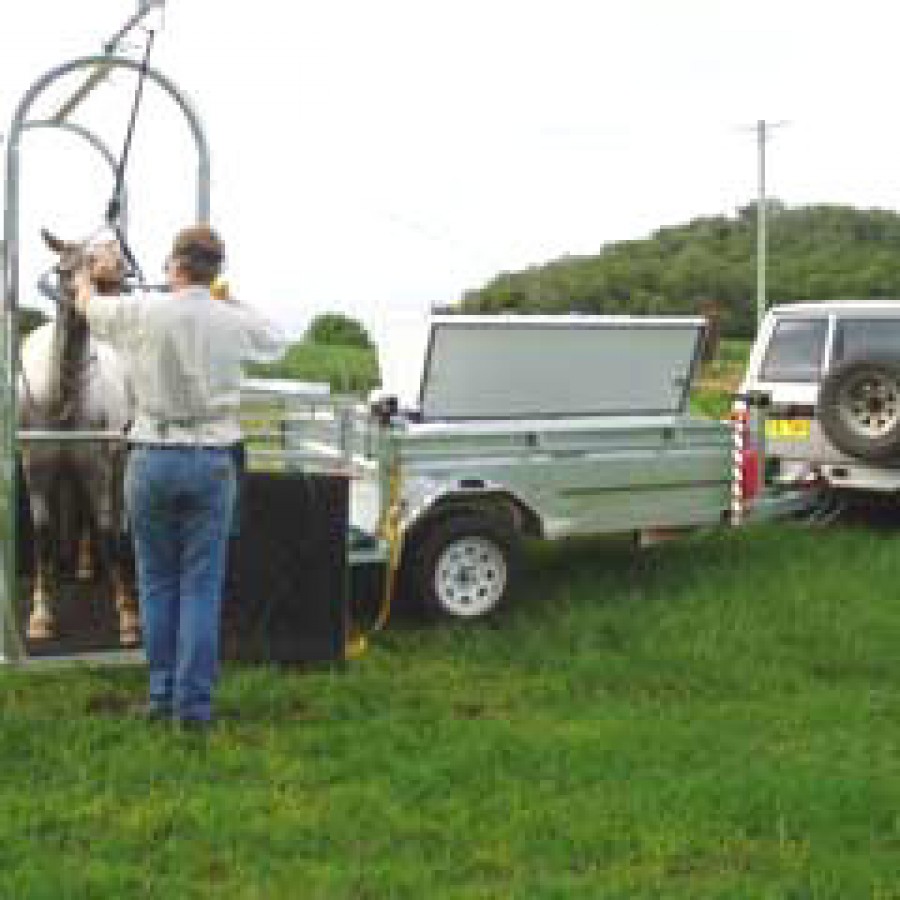

Horse's teeth are known as hypsodont teeth - which means they have long crowns. These long crowns continue to be worn down, with the horse chewing approximately 60 chews per minute, for 14-20 hours per day. As they are worn down, the teeth continue to erupt through the gums to keep in contact with the opposing tooth's grinding (occlusal) surface.
The adult horse usually has 36-42 teeth but can have up to 44 teeth as a mature 5 year old. The front teeth (incisors) are used to grip and cut the grass. The back or cheek teeth (premolars and molars) are used to grind up the food.
This grinding functions to cut the food into smaller pieces - which increases the surface area for digestive enzymes to act on. The chewing also stimulates saliva production. Saliva also contains digestive enzymes and has some bicarbonate in it to help with buffering of the stomach acids. Thus chewing is an essential first phase in gaining nutritional value from feed stuff.
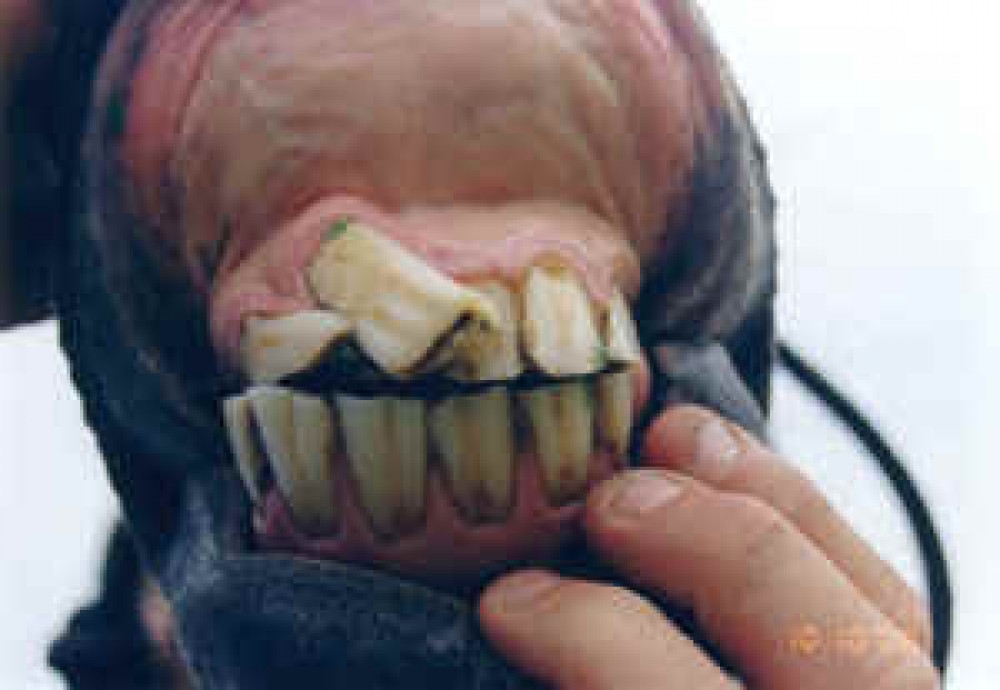 Traumatic avulsion of the incisor teeth. This is a common accident - often the result of a kick, or getting the teeth caught on mesh etc. Treatment of these accidents needs to be prompt, in order to save the teeth and restore them to their normal position.
Traumatic avulsion of the incisor teeth. This is a common accident - often the result of a kick, or getting the teeth caught on mesh etc. Treatment of these accidents needs to be prompt, in order to save the teeth and restore them to their normal position.
Inadequate chewing means inadequate nutrition.
The lower jaw (mandible) and upper jaw (maxilla) both accommodate an arcade of 6 cheek teeth on left and right sides. The upper jaw is wider than the lower jaw. This disparity is normal, but it does lead to the production of sharp points on the outside of the upper teeth, and the inside of the lowers. These sharp points are made up of enamel - the hardest material in the body. They often become extremely sharp - resulting in cutting to the cheeks and tongue.
These cuts can occur during chewing or when ridden - when the bit or halter pushes the cheeks into these sharp enamel points. The mouth is a very sensitive area - thus cutting its mucosa can lead to the horse altering its normal chewing pattern and misbehaving when ridden.
Removing these sharp enamel points is one of the many skills an equine dental practitioner aims to master.
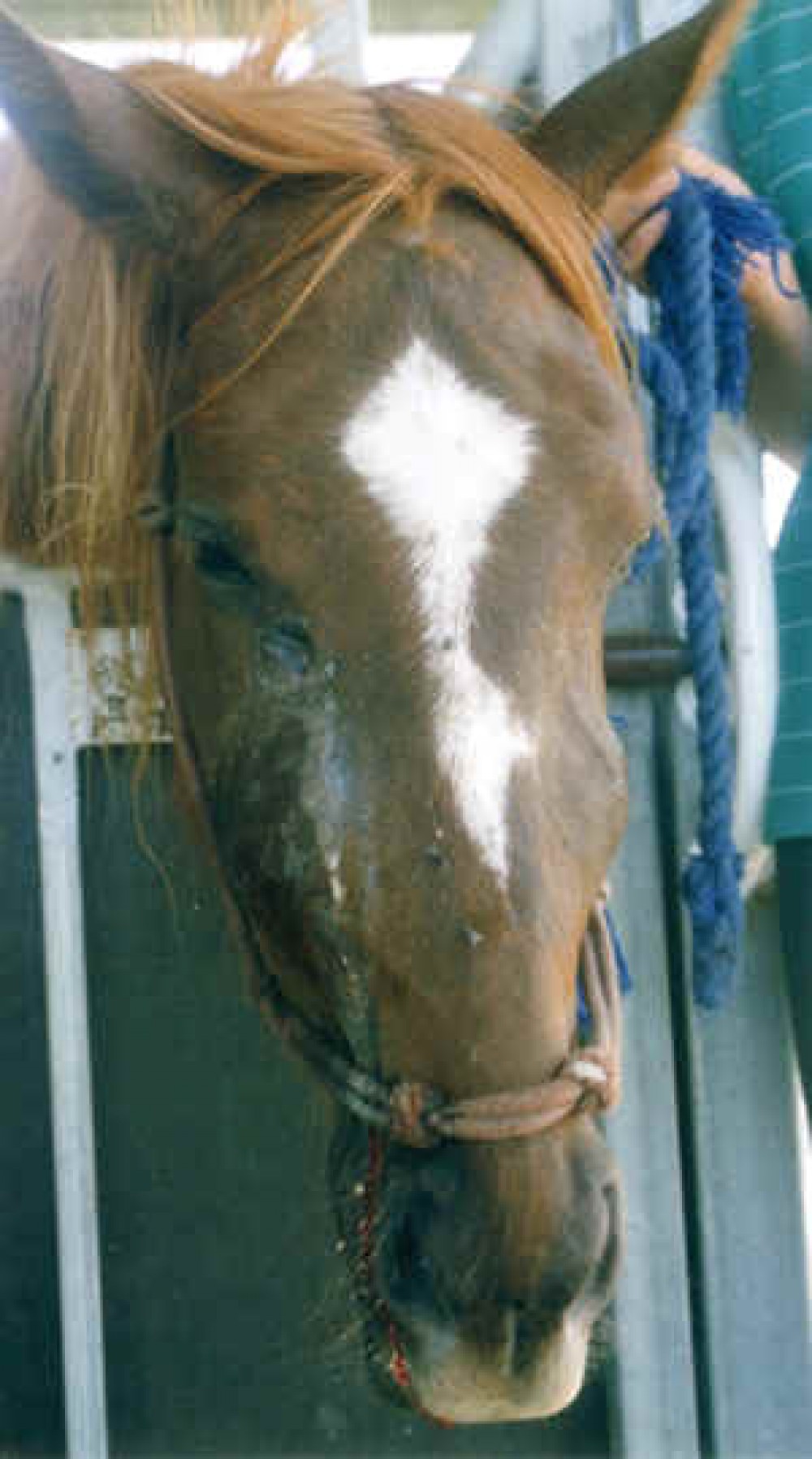 Sinusitis (where the face becomes swollen, due to the build up of pus in the sinus cavity) is a common sequelae to teeth problems. It sometimes shows up as simply a pus discharge from only one nostril. In this case, multiple teeth had abscessed, with a pus discharge from the swollen areas. Impacted baby teeth were the main cause of this problem, but a poor diet was also suspected.
Sinusitis (where the face becomes swollen, due to the build up of pus in the sinus cavity) is a common sequelae to teeth problems. It sometimes shows up as simply a pus discharge from only one nostril. In this case, multiple teeth had abscessed, with a pus discharge from the swollen areas. Impacted baby teeth were the main cause of this problem, but a poor diet was also suspected.
Thus Equine Dentistry is done for two reasons:
1) Comfort to the horse when eating and
2) Comfort to the horse when ridden.
 This horse was chewing only on one side - leading to this imbalance of the incisor teeth - known as a slant bite. This horse had been refusing to take the right lead, and tossed his head at trot to canter transition.
This horse was chewing only on one side - leading to this imbalance of the incisor teeth - known as a slant bite. This horse had been refusing to take the right lead, and tossed his head at trot to canter transition.
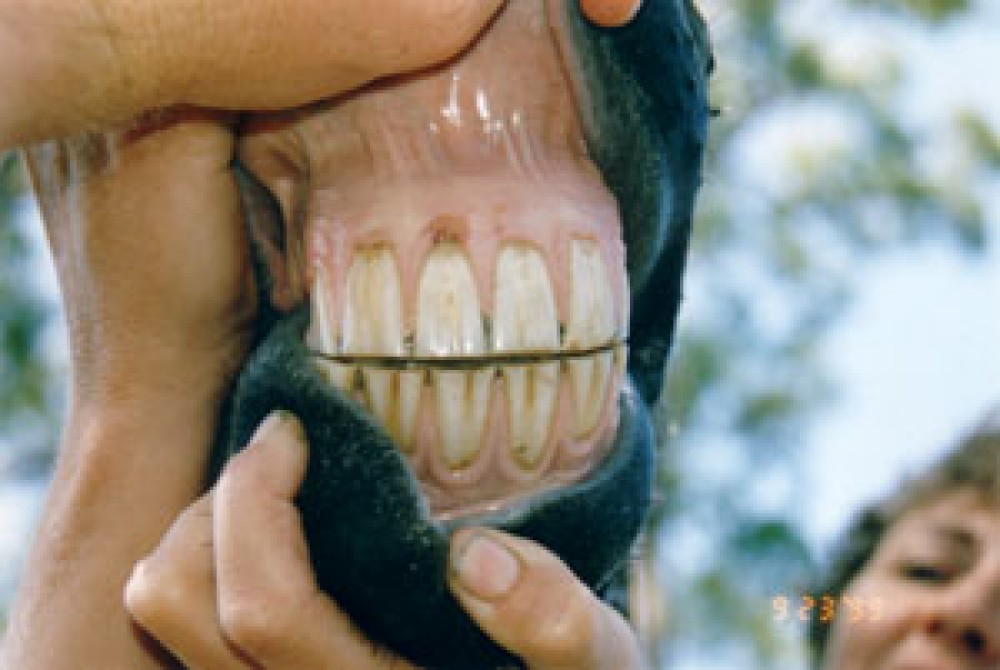
Incisor rebalancing was done, along with a rebalance of the cheek teeth. The horse immediately improved, taking the right lead, ceasing the head toss, and has gone onto become a very good show hack - being high up in the NSW rankings.
When horses are stabled and fed unnatural feeds ie everything except grass and hay - these sharp enamel points tend to develop faster, and so horses fed pellets, grains, chaffs etc will often need more frequent attention than grass or hay fed horses. This statement is merely a fact and does not mean you should not feed pellets, grains and chaffs.
People often ask me "what about wild horses?" Studies have shown that wild horses survive on average between 7 and 12 years - depending on the study you read. These horses are only eating grass and so will not develop sharp points as fast. However, if they do get a tooth problem, it usually continues to worsen until the horse cannot physically eat (thus the horse starves), or the horse colics or chokes due to inadequate chewing.
Unlike cats and dogs, horses will continue to eat whilst enduring enormous amounts of mouth pain eg fractured molars, periodontal disease, lacerated cheeks. So don't wait for your horse to display chewing problems before you have it checked out. For it may be too late.
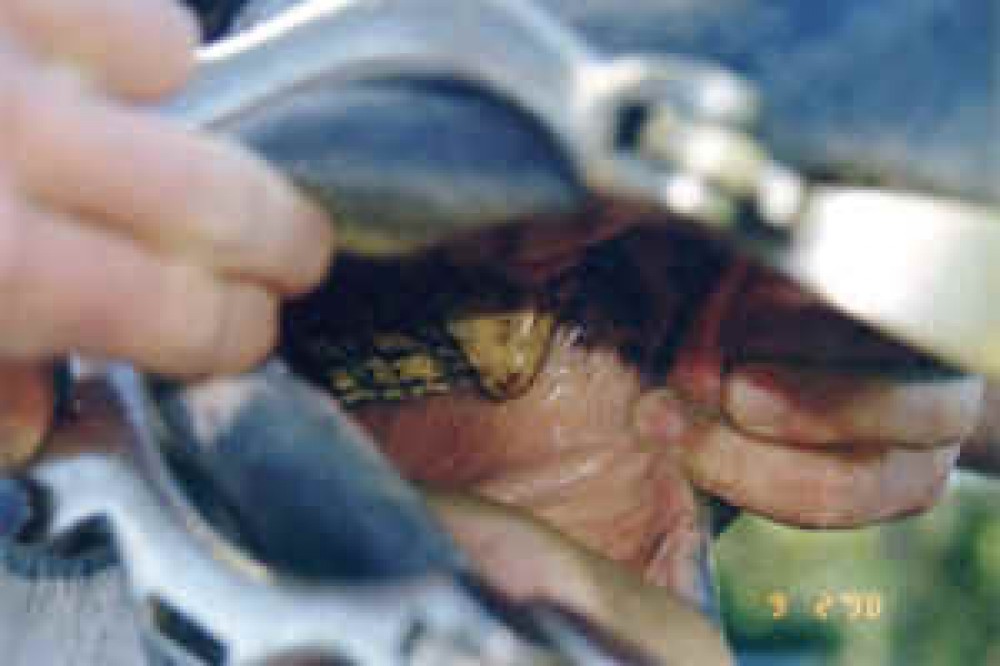
Elongation of the cheek teeth can occur. This upper rostral hook was causing the horse to resent bit contact and collection.
Signs of dental disease and resultant pain can be seen when eating
Eg. spilling feed, drooling saliva, quidding or balling of feed inside cheeks (to protect cheeks from sharp points), eating slowly, not grazing as much as expected, chewing on one side or with head tilted, toss head, chewing more up and down instead of from side to side, and frequently go to the water bucket whilst eating.
Signs may be evident when being ridden.
These signs include chewing the bit, head tossing, lugging on one side, getting behind the bit, rearing, not collecting, opening the mouth, bolting, pulling, becoming heavy on the forehand, drooling saliva, and refusal to take one lead. Some horse's are smart enough to become very difficult to even accept the bit, as they know it will cause them pain.
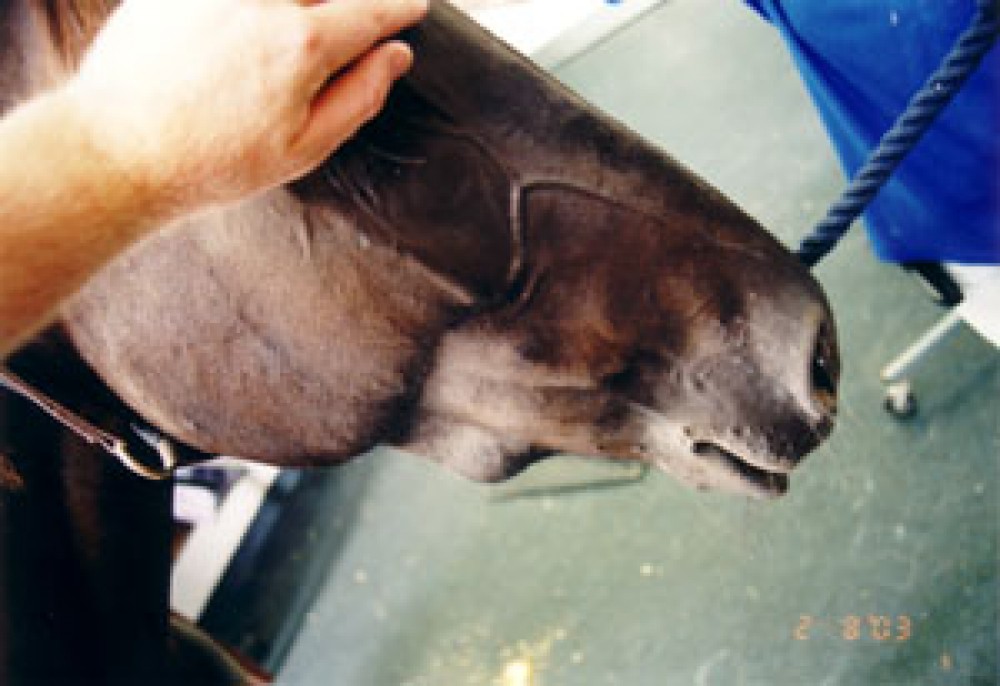
This 4 year old thoroughbred developed a hard, painful swelling under its jaw.
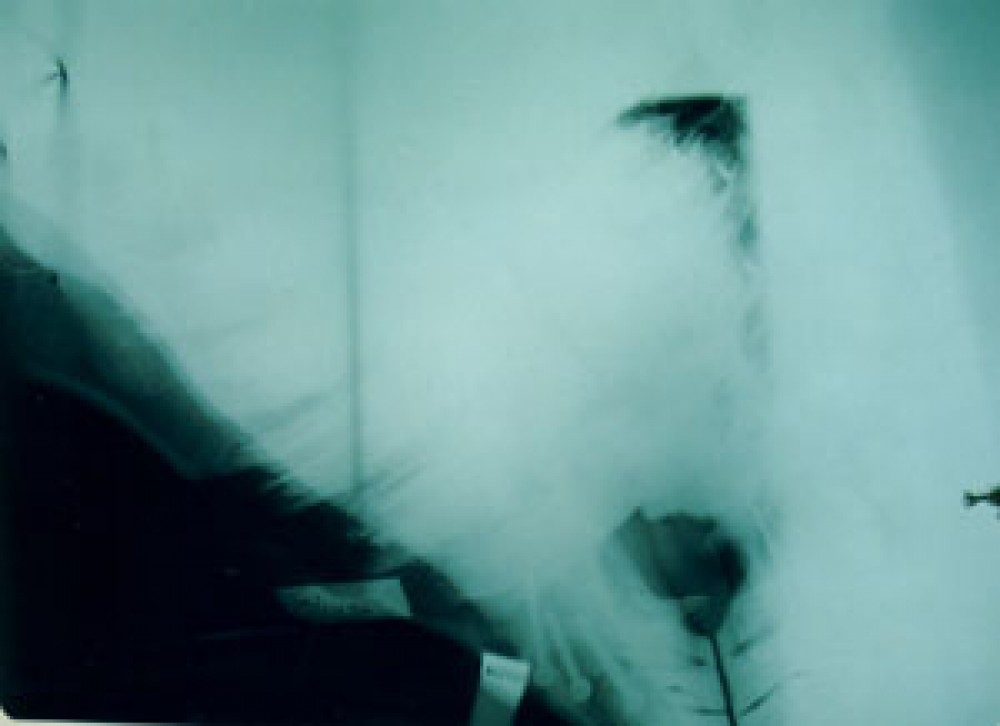 X-rays showed the presence of a tooth root abscess on the second lower cheek tooth. Radiographs are extremely important and commonly used in the diagnosis of oral disease.
X-rays showed the presence of a tooth root abscess on the second lower cheek tooth. Radiographs are extremely important and commonly used in the diagnosis of oral disease.
Other secondary problems can include long stems (over 1 cm length) in faeces, impaction colic bouts, choke, and recurring poll, neck and back problems. Weight loss, diarrhea, sinusitis, and facial swellings are others.
Obviously, the signs are many. One must remember that there is also tremendous variation in pain tolerance between horses and one horse may show signs with little pathology, and the next shows no signs despite major problems.
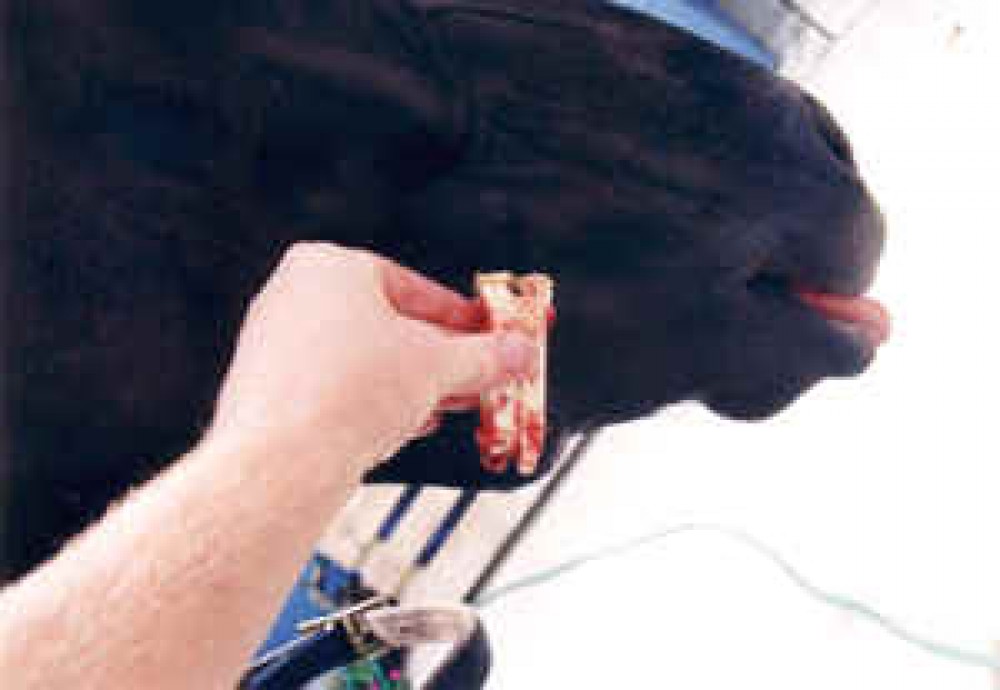 The horse was sedated in the porta-safe stocks, and a nerve block done. The premolar tooth was then extracted through the oral cavity - no surgery needed. This tooth was 9 cm long. Regular maintenance of the horse's mouth as a 2 and 3 year old could well have prevented this problem.
The horse was sedated in the porta-safe stocks, and a nerve block done. The premolar tooth was then extracted through the oral cavity - no surgery needed. This tooth was 9 cm long. Regular maintenance of the horse's mouth as a 2 and 3 year old could well have prevented this problem.
Frequency of dental visits does vary between horses, but as a rough guide, is as follows:
- always have teeth done BEFORE "breaking in" - the horse will accommodate the bit much more smoothly, and won't resist it and develop bad habits early, eg opening mouth, chewing bit, lugging etc.
- horses 0-2.5 years: every 6 months (especially if parrot mouthed or hand fed)
- 2.5 - 5 years: every 3-6 months (as this is when the caps or deciduous teeth are shed)
- horses 5-10 years of age: every 6 months - especially if hand fed
- horses over 10 years: every 12 months (more frequently if a specific problem is being addressed eg wave mouth)
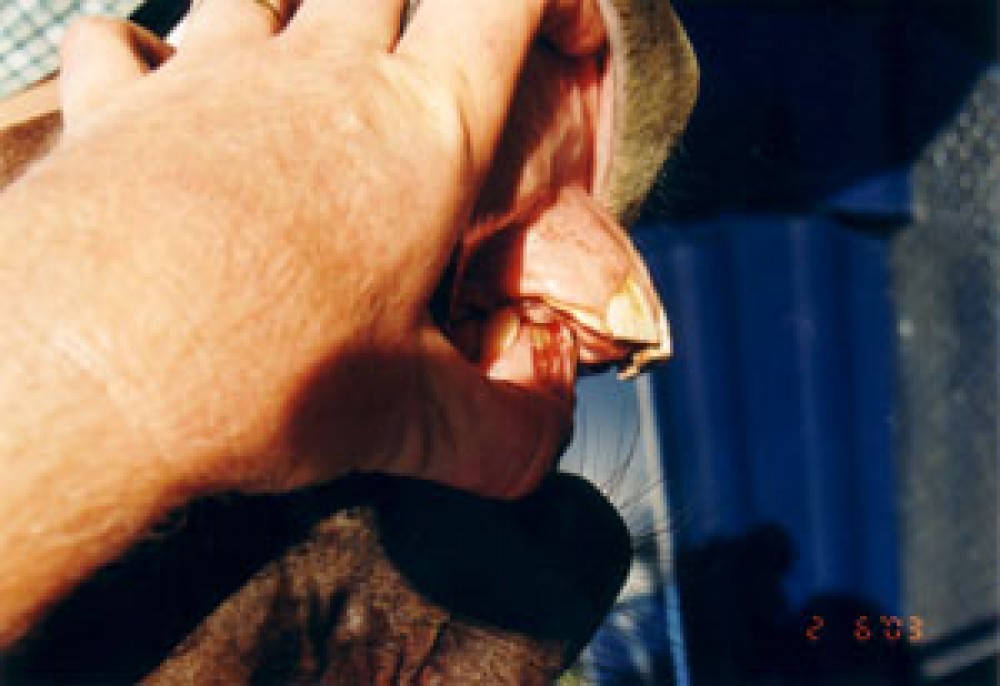 Severe parrot mouth (brachygnathism) in a 4 yo TB gelding. Chewing short grass is very difficult with this type of abnormality.
Severe parrot mouth (brachygnathism) in a 4 yo TB gelding. Chewing short grass is very difficult with this type of abnormality.
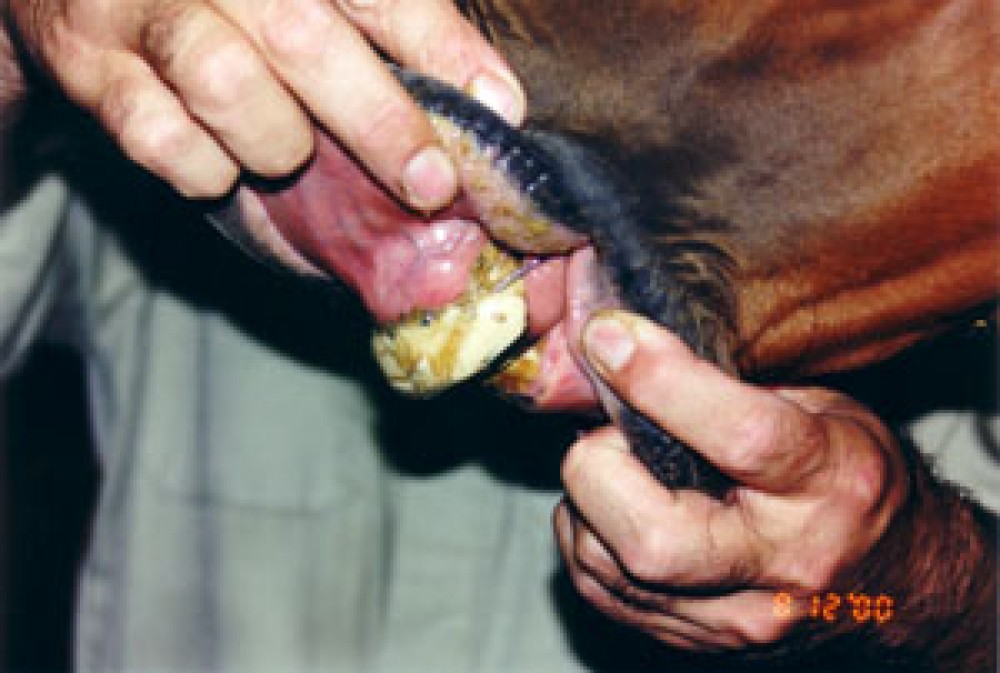
If detected in the first few months of life, parrot mouth can be minimised, or even corrected. This involves floating of the teeth, and possibly the use of plates and wires (orthodontics). This thoroughbred yearling has wires and acrylic on her upper incisor teeth, to hold them back, whilst the lower jaw grows. Obviously this is a very expensive procedure, and several general anaesthetics and wire replacements etc need to be done over 6-12 months.
Another role for an equine dental practitioner is to extract wolf teeth. Wolf teeth are small, useless teeth and are positioned just in front (but up to 3cm in front) of the first cheek teeth. The problem with these teeth is that they do have a nerve supply and they can become painful when contacted by the bit - resulting in an intermittent head toss. Another problem is that they get in the way when the dentist is contouring the first cheek teeth in order to set up the mouth to accommodate the bit pain free, ie when doing a "bit seat".
Wolf teeth should only be extracted, and not hit out with a chisel or screw driver as was once done. This knock out procedure usually leaves most of the root in the tooth socket, which can create more problems. The equine dental practitioner will also aim to achieve balance in the mouth.
Mouth balance is as important to the equine athlete as is nutritional or foot balance.
Achieving balance will see a horse stop dropping its feed, chewing pain free in all directions and on both sides of the mouth, have symmetry of occlusal surface angles in all quadrants of the mouth, and the incisor bite will be even and straight across - not slanting down one way or in a frown or smile shape
Mouth balance is much more than removing sharp enamel points. It requires knowledge and experience - but is where the true value of equine dentistry lies.
Balance in the mouth is the key to a horse being able to adequately "cleanse" its own mouth whilst eating. With free motion in all directions, the teeth remain in correct alignment, and impaction of food in pockets is largely prevented. It is this food impaction which eventually leads to the chronic infection around the tooth - known as periodontal disease. Advanced periodontal disease will lead to the tooth loosening, possibly developing tooth root abscessation, and needing to be extracted orally, or surgically removed - an expensive procedure.
Removal of the diseased tooth will usually leave the horse out of pain and free of infection in the mouth. However, it is not good to see a horse begin to lose its teeth at a young age (less than 20 years).
Obviously prevention is always better than cure.
Equine dentistry has become a popular topic world wide over the past 2 decades. It is, however, far from being a new field of knowledge. Vet textbooks from the 17th and 18th centuries contain mainly information on equine dentistry and foot care. This was an era when the horse was so crucial economically. The introduction of the motor car saw the horse's economic value decline rapidly, and a lot of husbandry practices were neglected. Dentistry more so, as it is out of sight of most owners, and can be difficult to perform without adequate skills, tools and restraint to the horse.
It is the "horse boom" of the past decade which has really catapulted dentistry back into the limelight. Owners are aiming to climb to greater heights with their horses than in the past half a century.
